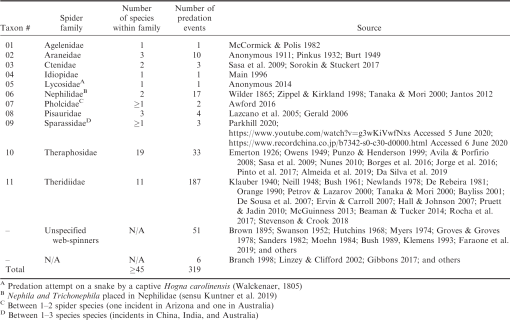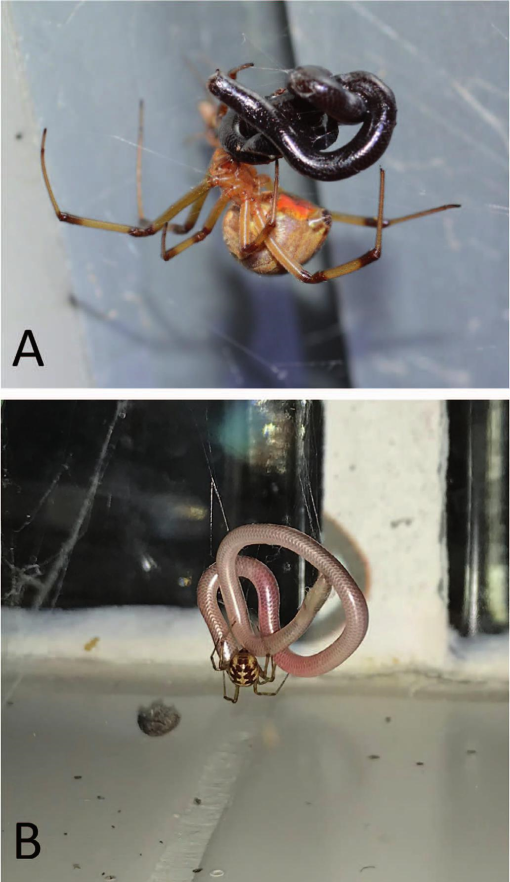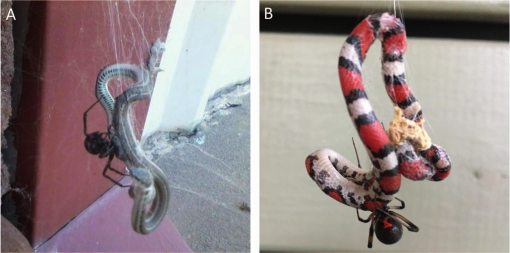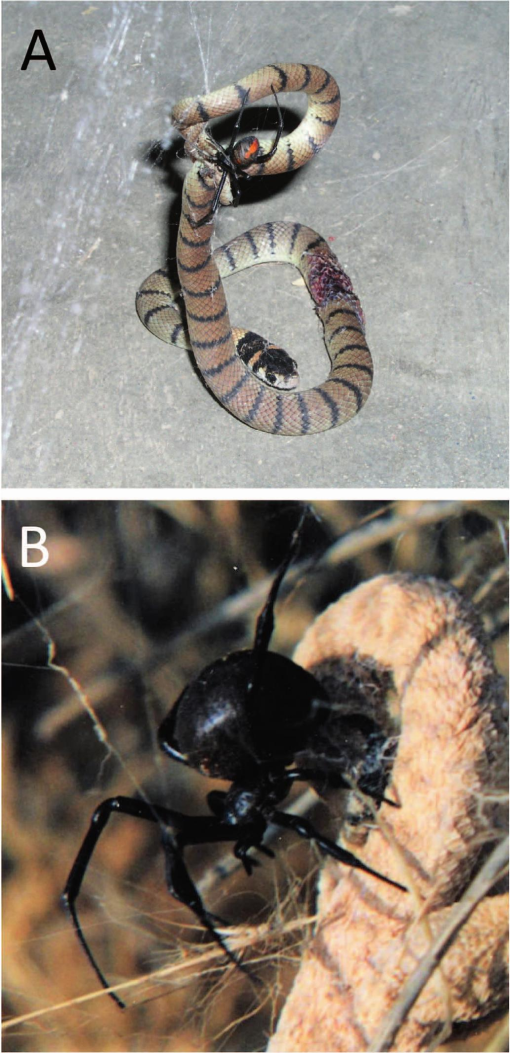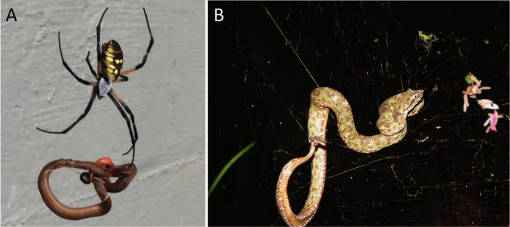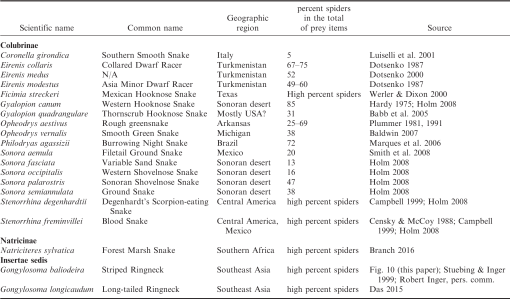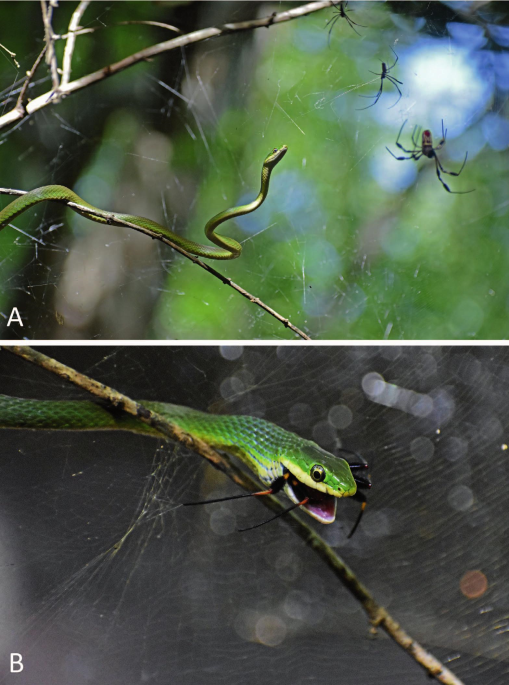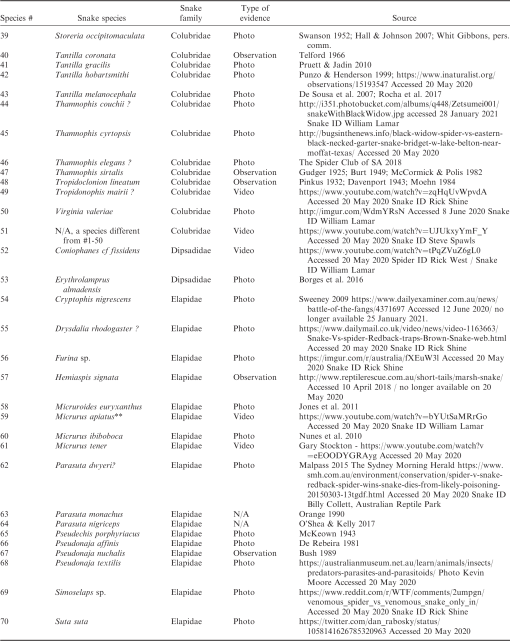Table 1.
Spider families engaged in snake predation or predation attempts (based on 319 incidents reported in the scientific literature or in the social media). Evidence based on field observations except for Lycosidae.
Figure 1.
Blind snakes killed in webs of theridiid spiders. A. Brown widow spider, Latrodectus geometricus, feeding on a Brahminy blindsnake, Indotyphlops braminus (Typhlopidae), in a garden house in Zaachila, Oaxaca, Mexico (Photo by Matias Martinez). B. Texas Blind Snake, Rena dulcis (Leptotyphlopidae), trapped in web of the theridiid spider Steatoda triangulosa in a building near San Antonio, Texas, USA (Photo by George Popescu).
Figure 2.
Theridiid spiders capturing colubrid snakes. A. Southern Ringneck Snake, Diadophis punctatus punctatus (Colubridae), caught in a spider web in a garage in Virginia, USA (Photo by Erika Packard). The spider in question was a non-widow theridiid (most likely Parasteatoda tepidariorum (C. L. Koch, 1841)). B. Juvenile Eastern garter snake, Thamnophis sirtalis, trapped in a brown widow web (Latrodectus geometricus) observed in Douglas, Georgia, USA (Photo by Julia Safer).
Figure 3.
Black widow spiders killing colubrid snakes. A. Lined snake, Tropidoclonion lineatum (Colubridae), killed in web of black widow spider (Latrodectus sp.) in a building in Tulsa, Oklahoma, USA (Photo by Jeff Lewis). B. Juvenile scarlet snake (Cemophora coccinea, Colubridae) entrapped on web of Latrodectus geometricus, observed in a private residence in Georgia, USA (Photo by Daniel R. Crook).
Figure 4.
Black widow spiders killing snakes. A. Scarlet snake (Cemophora coccinea) entrapped and killed in a black widow web (Latrodectus sp.) in the corner of the front porch of a house in Gulf Breeze, Florida, USA (Photo by Trisha Haas). B. Adult female black widow (Latrodectus hesperus) feeding on a subadult coral snake Micruroides euryxanthus (Elapidae) near the Boyce Thompson Arboretum, Superior, Arizona, USA (Photo by Lawrence L. C. Jones).
Figure 5.
Black widow spiders killing snakes. A. Juvenile Eastern brown snake, Pseudonaja textilis (Elapidae), killed by a redback spider (Latrodectus hasselti) in Australia (Photo provided by the Australian Museum, © Kevin Moore). B. Widow spider, Latrodectus revivensis, was feeding for several days on a dead sand viper Cerastes vipera (Viperidae) in the Negev desert (Photo by Ori Segev).
Figure 6.
Tarantulas killing and eating snakes. A. Fer-de-lance, Bothrops atrox, captured, killed and consumed by a Theraphosa blondi in Venezuela (staged incident photographed by Rick West). B. Theraphosa blondi capturing a juvenile false coralsnake, Oxyrhopus sp. (Colubridae), ≈30 cm in length, on forest floor at Senador José Porfírio municipality, Pará state, Brazil. Subsequently, the spider transported the snake to its burrow (Photo by Karll Cavalcante Pinto).
Figure 7.
Nonweb-building spiders killing and eating snakes. A. Adult male tarantula (Brachypelma sp.) preying on a juvenile fer-de-lance, Bothrops asper (Viperidae), in the Yaxchilan Archaeological Zone, Chiapas, Mexico (Photo by Silvano Lopez & Danniella Sherwood; © Silvano Lopez). B. Fishing spider Dolomedes tenebrosus Hentz, 1844 preying on a Middle American burrowing snake, Adelphicos quadrivirgatum (Colubridae), in the La Estanzuela Natural Park, Nuevo Leon State, Mexico (Photo by Salvador Contreras-Arquieta).
Figure 8.
Snakes killed by large orb-weaving spiders. A. Argiope aurantia Lucas, 1833 eats red-bellied snake, Storeria occipitomaculata (Colubridae), in North Carolina (Photo by Eleanor Spicer Rice). B. Eyelash Viper Bothriechis schlegelii (Viperidae), ≈40 cm in length, has been captured in web of Trichonephila clavipes (Nephilidae) in Costa Rica rain forest (Photo by Jonathan Sequeira).
Table 2.
Total lengths and body weights of selected snake species based on literature data.
Table 3.
Snake families reported to be victims of spider predation (based on 319 incidents reported in the scientific literature or social media).
Table 4.
Toxicity of spider and snake venoms injected in mice (LD50 values based on literature). Route of injection: IM = intramuscular injections; IP = intraperitoneal injection; IV = intravenous injection; SI = subcutaneous injection. Low LD50 values indicate high toxicity. Available online at http://snakedatabase.org/pages/ld50.php Accessed 5 June 2020.
Figure 12.
Relationship between spider body length and snake body length based on 86 available data pairs. Snake body length refers to total length (snout-vent length + tail length), whereas spider body length refers to cephalothorax plus abdomen. A low positive correlation (r = 0.4136; P < 0.01) between snake body length and spider body length was found.
Figure 9.
Juvenile Sonoran gopher snake (Pituophis catenifer) found in a building in Salem, Oregon. Its head and much of its body was wrapped up in spider webbing with other detritus (i.e., gum, small bits of paper, and pebbles) attached to it, and it is assumed that the snake either was wrapped up in spider webbing after having escaped from a spider web, or that it picked up the pocket of webbing along with the detritus while passing under a door from the building to inside. The snake's view was strongly obstructed by the amount of webbing engulfing its head indicating that its chance of survival would have been severely diminished if the bag of webbing on its head had not been removed by the human who found it in the building (Photo: Tim Akimoff).
Table 5.
Spider families engaged in predation on reptiles based on literature data.
Table 6.
Examples of colubrid snake species reported to feed on spiders, with percent spiders in the snakes' total diet (based on literature data).
Figure 10.
A., B. Orange-bellied ringneck snake (Gongylosoma baliodeirum) eating a wandering spider, Ctenus sp., observed in the Central Catchment Nature Reserve, Singapore (Photos by Holly C. Chapman).
Figure 11.
Snake attack on Trichonephila clavipes spider photographed in West Ashley, South Carolina, USA (Photos by Max Roberts/iNaturalist CC BY-NC). A. Rough green snake, Opheodrys aestivus (Colubridae), approaches webs of Trichonephila clavipes with the attempt to catch a spider. B. Rough green snake, Opheodrys aestivus, has captured a Trichonephila clavipes spider and is swallowing it.
Appendix 1.
List of spider species engaged in predation (or predation attempts) on snakes. * In captivity or in staged field experiments; ** Presumably a staged event; *** Staged field experiment.
Appendix 2.
List of snake species reported having been captured by spiders. * Staged feeding experiment; ** Species name based on the revision of Reyes-Velasco et al. (2020).


